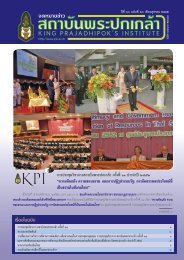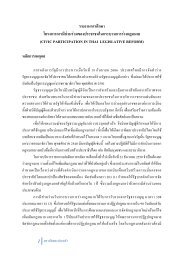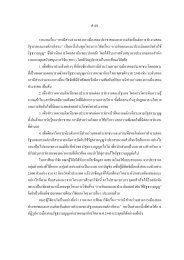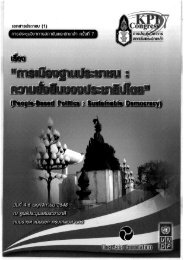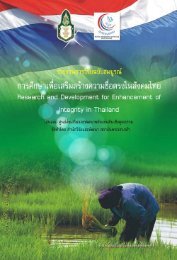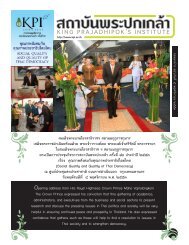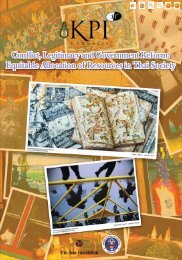SUFFiciENcy EcONOMy ANd GRASSROOtS DEvElOPMENt
SUFFiciENcy EcONOMy ANd GRASSROOtS DEvElOPMENt
SUFFiciENcy EcONOMy ANd GRASSROOtS DEvElOPMENt
Create successful ePaper yourself
Turn your PDF publications into a flip-book with our unique Google optimized e-Paper software.
The Meaning of Sufficiency Economy <br />
International Conference<br />
225<br />
have been particularly attractive to young men (between 18 and 45) from Ban Nôn<br />
g Tün. In 2005 26 men from the village had taken 2-3 year contracts to work in T<br />
aiwan. Another 34 men had already worked there.<br />
A young man in B?n Nông Tün just back from working three years at a<br />
factory in Taiwan with his wife, his mother-in law, and son, 2005. Note<br />
electric clothes washing machine purchased with money he had made. (photo<br />
by Charles Keyes)<br />
What is particularly noteworthy is that most migrants whether they work in<br />
Thailand or work abroad return to the village. If men or women leave before<br />
marriage, they may well end up marrying someone who is not from the village.<br />
Women who do so typically will bring their husbands to live with them in the<br />
village. Men (and some women) who leave after marriage see their work as essential<br />
providing support for their families. Their incomes as well as remittances sent back<br />
before they return makes it possible for their families to have suburban style homes<br />
and to have many consumer goods associated with the middle class.<br />
Photo on left shows the totality of household belongings of a woman in<br />
1963 who was the great grandmother of the boy on the right in the house in<br />
2005 of his aunt and uncle (photos by Jane Keyes)<br />
Monies earned outside the village are also now often used to invest in new<br />
local enterprises. These enterprises include convenience stores, small restaurants,<br />
vehicle repair shops, and pickups for transporting goods and people. At the most<br />
patronized convenience store the most popular item for sale were cellphone cards<br />
used primarily for villagers to stay in contact with relatives working elsewhere in<br />
Thailand or abroad. <br />
Some also invest in agriculture, purchasing small tractors or other equipment<br />
which is hired out. And some villagers invest in a traditional form of wealth –<br />
namely cattle – albeit in some cases of a newer and more expensive breed. Today,<br />
Ban Nông Tün, like most other villages in northeastern Thailand, is far from the near<br />
ly self-sufficient agricultural community we first observed in the early 1960s.<br />
The Village Remains a Moral World<br />
While those who are born in Ban Nông Tün may spend most of their liv<br />
es away from the village, most continue to retain a sense of membership in a moral<br />
community that is manifest in the village. The wat today contains entirely new<br />
structures compared to the early 1960s. Almost all the new structures have been<br />
financed through merit-making rituals organized by those working away from the<br />
village. Some men return to the village to ordain at the wat, while more become lay<br />
followers after they retire.<br />
The village today has two monastic establishments. In addition to the<br />
traditional wat, since the 1980s one or two forest monks have found a place to reside<br />
in either the forest associated with the phîpûtã, the tutelary spirit of the village, or in



